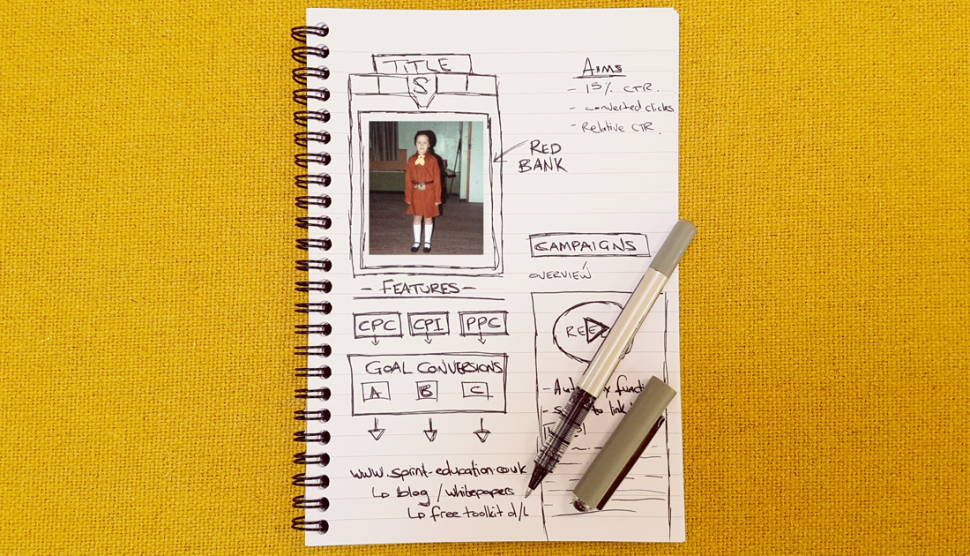How to Hatch Your Next Project Using a Wireframe
How to Hatch Your Next Project Using a Wireframe
This blog takes you through the first steps of turning your edu-marketing project pipe dreams into reality.
This blog takes you through the first steps of turning your edu-marketing project pipe dreams into reality.
Wireframing. This is a term I’d heard countless times flying between the technical team but it wasn’t something I was entirely familiar with. Risking my tenuous tech-cred by asking the meaning wasn’t an option, so I put it on my list of other cool phrases they used like ‘elastic search’ to come back to later.
If truth be told wireframing only ignited images in my mind of glory days back in the 1990’s when I was a Brown Owl worshipping badged-up Brownie. The only type of wireframe I’d ever come across was during the run up to the annual town carnival. As a brigade of Brownies, we came together, promising to do our best (of course) at decorating the club float to parade through our town whilst saluting to the public until our arms ached. This particular year the theme of our float was ‘Nature’. Brown Owl laid out the task before us – we were to create life-sized papier-mâché woodland creatures, done so with the use of a chicken wire frame on which we’d plaster our scraps of sticky newspaper.
Surely, this has nothing to do with the wireframing our techies refer to? Well, in a way it really does.

Here’s how…
I was having a problem with visualising the structure of our social media plan for the coming year. We hold so much wisdom on marketing to schools in various forms – blogs, case studies, whitepapers, infographics - you name it, that even though I had tonnes of notes on my Trello board and in my jotter, nothing was helping me to bring it all together to build a plan I could work with over the period of a year. It was only whilst taking my usual thrashing at table tennis that I happened to mention my conundrum to Guy, our Technical Director. His answer was, ‘Why don’t you create a wireframe?’
From there and forever more my Papier-mâchéing days dissolved from my imagination whenever I hear this term.
It turns out that wireframing is exactly as it sounds – a visual foundation on which to begin building. Three key elements within a wireframe chime; build, change, share. They are commonly used during web design processes, but in essence everyone’s a designer so its principles can be applied to many types of project planning.

In my instance, it was a perfect solution on which to ‘build’ our social media strategy for the coming year. Using its simple ethos of building a basic block diagram containing the various elements of our social media content, timings on which the elements could be used, and which interfaces the posts will be published, it really helped solve my problem. Finally, I had a way of visualising the content and how it would all fit together. I could ‘change’ the content throughout the year as new blogs, whitepapers, and infographics were produced and importantly I could ‘share’ this framework with my colleagues who’d then have an understanding of our social media strategy. Our Blueprint for Success is also a perfect example of how a less conventional use of a wireframe applies, to develop a primed marketing to schools strategy. We’ve also used the principles of wireframing and applied these to the development of our Google AdWords and SEO strategies.
So, if you’re struggling to get started on your next project perhaps it’s time to consider wireframing. Even the simplest of wireframes can be ever so useful, you don’t necessarily need fancy software (or papier-mâché) to get you kick-started. Here’s a few simple things to consider to get you going…
Content
The key to building a useful, structured wireframe is being clear before you begin exactly what it is you want to cover within it. Make a list of what needs to be included.
Organise
Use sub-headers and titles for the content arranged by topic or function. When sharing the wireframe with your colleagues it’ll be easier to assign certain elements to certain people. Setting a hierarchy of which elements are most important to include within the project can also be a great way to ensure the most important parts of the project are completed first.
End Goals
What your project needs to achieve needs to be written down and documented. Be clear and concise here, this will help when the project is shared, ensuring everyone who contributes is focussing on the exact same outcome.
Tags
Database of Teachers
Design
Education Marketing
Email Design
How to Sell to Teachers
Website
Similar Articles


Marketing Teacher Training and Courses to Schools
Learn 10 game-changing insights especially for teacher training and course providers to enhance your education marketing campaigns when emailing schools.


VIDEO: School Priorities and How You Can Target Them
Teacher priorities for 2023, and how you can help schools achieve their goals with your products, services, and offers.


Expert marketing to schools support and solutions
Expert marketing to schools solutions
Email Head Teachers, Teachers, and Staff Inboxes
Email teachers and staff inboxes
Sell More to UK and Global Schools and Colleges
Sell more to schools and colleges






























